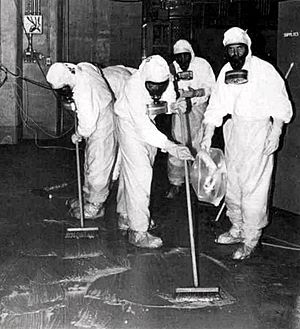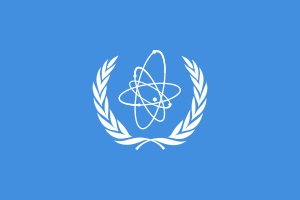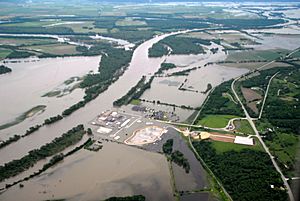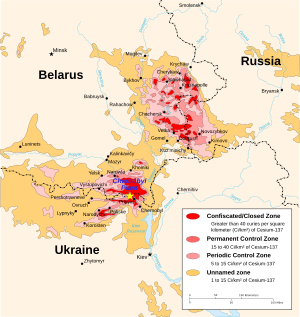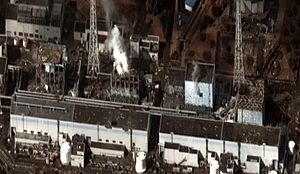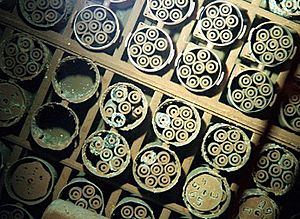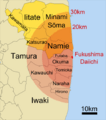Nuclear safety and security facts for kids
Nuclear safety is all about making sure that nuclear technology is used in a way that protects people, workers, and the environment from harmful radiation. It involves running nuclear facilities correctly, preventing accidents, and being prepared if an accident does happen.
A related idea is nuclear security, which focuses on protecting nuclear materials and facilities from being stolen or used for harmful purposes.
These safety and security rules apply to many things, including:
- Nuclear power plants that generate electricity.
- The transportation of nuclear materials.
- The use of radioactive materials in medicine and science.
- Military uses of nuclear technology.
The nuclear industry has worked to make its reactors safer over the years and has designed new types that are even safer. However, no system is perfectly safe. Problems can happen because of human mistakes or unexpected events, like natural disasters. For example, the designers of the Fukushima power plant in Japan did not expect a tsunami so large that it would knock out their backup power systems.
Safety for nuclear weapons is usually handled by different groups than those that watch over civilian (non-military) power plants, often because of secrecy.
Contents
What is Nuclear Safety?
Nuclear safety is about controlling nuclear power and radioactive materials to keep everyone safe. This includes several key areas:
- Power Plants: Making sure the reactors that create electricity are running safely.
- Nuclear Fuel: Safely handling fuels like uranium and plutonium from the time they are mined to when they are used.
- Radioactive Materials: Using materials safely in hospitals, for research, and even in space projects.
- Nuclear Waste: Managing and storing the leftover radioactive materials, known as nuclear waste, so they don't harm the environment.
- Future Technology: Researching future energy sources like nuclear fusion, which is still being developed.
The main goal is to limit the amount of radiation people are exposed to. This means making sure radioactive materials are not breathed in, eaten, or touched, and keeping them contained.
Who is in Charge of Nuclear Safety?
International Level
The main international group is the International Atomic Energy Agency (IAEA). The IAEA works with countries around the world to promote the safe, secure, and peaceful use of nuclear technology. It creates safety standards and offers advice to its member countries.
After major accidents like Three Mile Island and Chernobyl, the IAEA helped create the Convention on Nuclear Safety. This is an agreement where countries promise to maintain a high level of safety at their nuclear plants. In 2014, this agreement was updated with the Vienna Declaration on Nuclear Safety, which added new principles, including:
- New power plants should be built to prevent accidents and, if one happens, to limit the release of radioactive material.
- Existing plants must have regular safety check-ups to find ways to make them safer.
- Countries should use IAEA safety standards to make their own rules.
Some people think the IAEA should have more power to enforce these rules, not just recommend them.
National Level
Most countries that use nuclear power have their own government agencies to regulate safety. In the United States, this is the Nuclear Regulatory Commission (NRC). In the United Kingdom, it's the Office for Nuclear Regulation (ONR).
These national groups are responsible for inspecting power plants, giving them licenses to operate, and making sure they follow all safety rules. It is important for these agencies to be independent so they can make decisions based on safety alone.
Keeping Nuclear Power Plants Safe
How Plants are Designed for Safety
Nuclear power plants are very complex machines. Because of this, they are built with many layers of safety systems. If one part fails, there are backup systems to take over.
However, unexpected things can still happen. The Three Mile Island accident in 1979 showed how a series of small problems could lead to a bigger one. A small failure led to another, and then another, until the situation became very serious. This accident taught engineers important lessons about designing better safety systems and training workers for unexpected events.
Protecting Plants from Dangers
Nuclear plants must be protected from all kinds of threats, both natural and human-caused.
Natural Disasters
Many plants are built on coasts to use ocean water for cooling. This means they must be designed to survive floods and tsunamis. The Fukushima accident in 2011 was caused by a massive tsunami that was larger than the plant's sea wall could handle.
Plants in areas with earthquakes, like Japan and the west coast of the U.S., must be built on special foundations to withstand shaking.
Outside Threats
Plants are also protected from deliberate harm. They have strong fences, electronic monitoring, and armed guards. The most important parts of the plant, like the reactor, are housed inside a very strong containment building. This building is made of thick, reinforced concrete designed to stop radiation from getting out and to protect the reactor from impacts from the outside, like an airplane crash.
Learning from Accidents
Even with many safety measures, serious accidents have happened. These events are rare, but they have had a big impact on the industry.
Chernobyl, 1986
The Chernobyl disaster in Ukraine (then part of the Soviet Union) is considered the worst nuclear accident in history. A flawed reactor design and mistakes made by workers during a safety test caused an explosion and fire. A large amount of radioactive material was released into the atmosphere, spreading over Europe. The accident led to major changes in safety procedures and reactor design around the world. It also showed the importance of being open and honest when an accident happens.
Fukushima, 2011
In 2011, a massive earthquake and tsunami hit Japan. At the Fukushima Daiichi nuclear plant, the tsunami flooded the site and knocked out both the main power and the backup generators. Without electricity, the cooling systems failed, and three of the reactors overheated, leading to a nuclear meltdown.
This accident showed that even a technologically advanced country could have a major accident if it did not prepare for "beyond design basis events"—disasters that are worse than what a plant was built to handle. Since Fukushima, nuclear plants worldwide have improved their protections against natural disasters and power loss.
The Challenge of Nuclear Waste
After nuclear fuel is used in a reactor, it becomes highly radioactive waste. This waste is dangerous and must be kept away from people and the environment for a very long time.
Some parts of the waste are very radioactive but lose their radioactivity relatively quickly (in a few hundred years). Other parts are less radioactive but stay that way for thousands of years.
Currently, most used fuel is stored in special water pools or in large, strong concrete containers at the power plant sites. The long-term plan in most countries is to bury the waste deep underground in a deep geological repository. This would keep it safely locked away for thousands of years until its radioactivity fades. Finding the right place and building these repositories is a major challenge.
The Human Factor in Safety
Even the best-designed plant needs to be run by people. That's why a strong safety culture is so important. A safety culture means that every single person working at a plant—from the managers to the engineers to the maintenance crew—makes safety their number one priority.
Human errors can cause accidents. People can make mistakes, especially in stressful situations. To prevent this, workers go through a lot of training. Procedures are written down to be followed carefully, and many safety systems are automated so they work without a person needing to flip a switch.
The Future of Nuclear Safety
Newer and Safer Reactors
Engineers are always working on new reactor designs that are even safer. Newer plants, often called Generation III reactors, have more advanced safety features. Many of these features are passive, meaning they work automatically using natural forces like gravity, not electricity or human action. For example, if the power goes out, special valves might open automatically to let cooling water flow down onto the reactor core.
Future designs, called Generation IV reactors, aim to be even safer and produce less waste.
Nuclear Fusion: A Different Approach
The nuclear power we use today comes from fission, which means splitting atoms apart. Scientists are also working on nuclear fusion, which is the process that powers the sun. Fusion joins small atoms together to release energy.
Fusion has the potential to be much safer than fission. It does not create long-lasting radioactive waste, and a meltdown-type accident is not possible. However, creating a fusion reactor is extremely difficult. Scientists are working on a huge international project called ITER in France to test the technology, but it will likely be many decades before fusion power is used to generate electricity.
Images for kids


